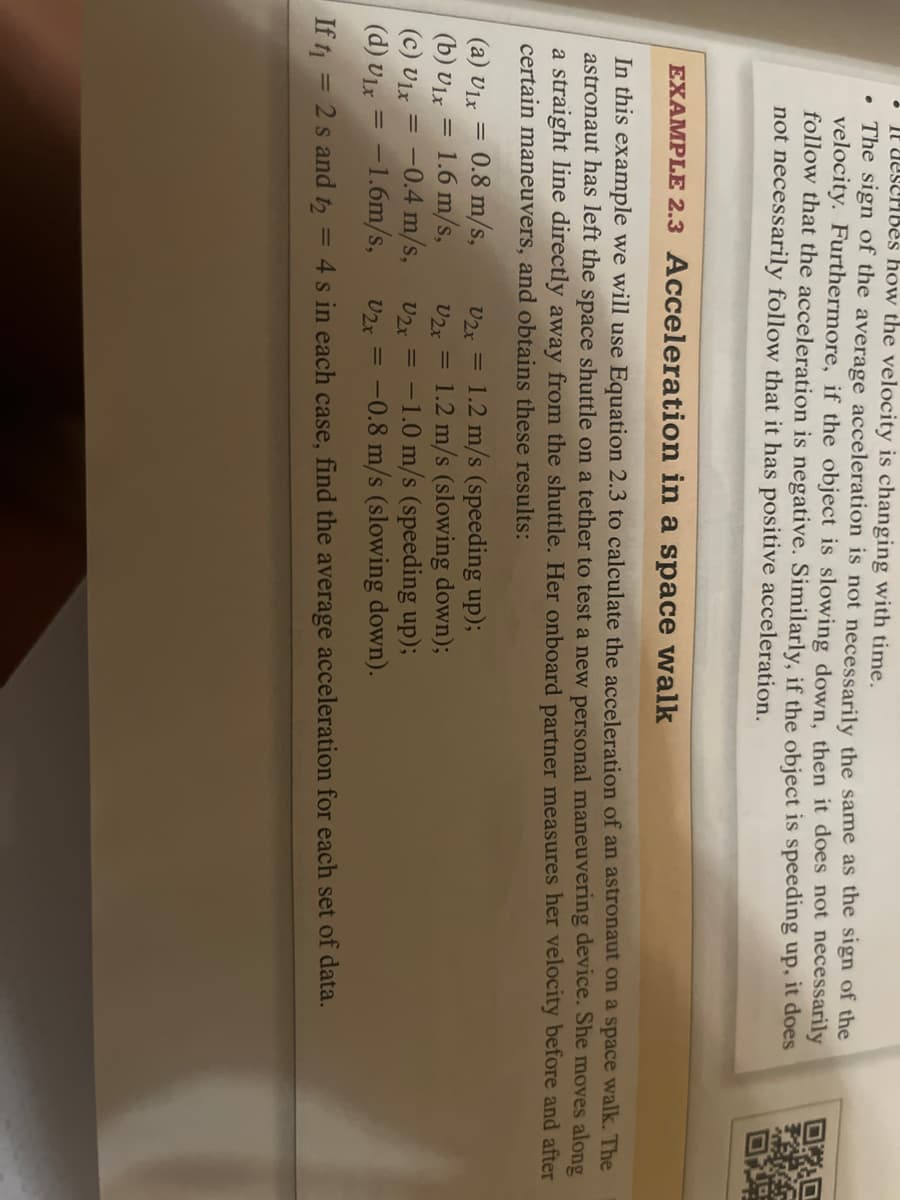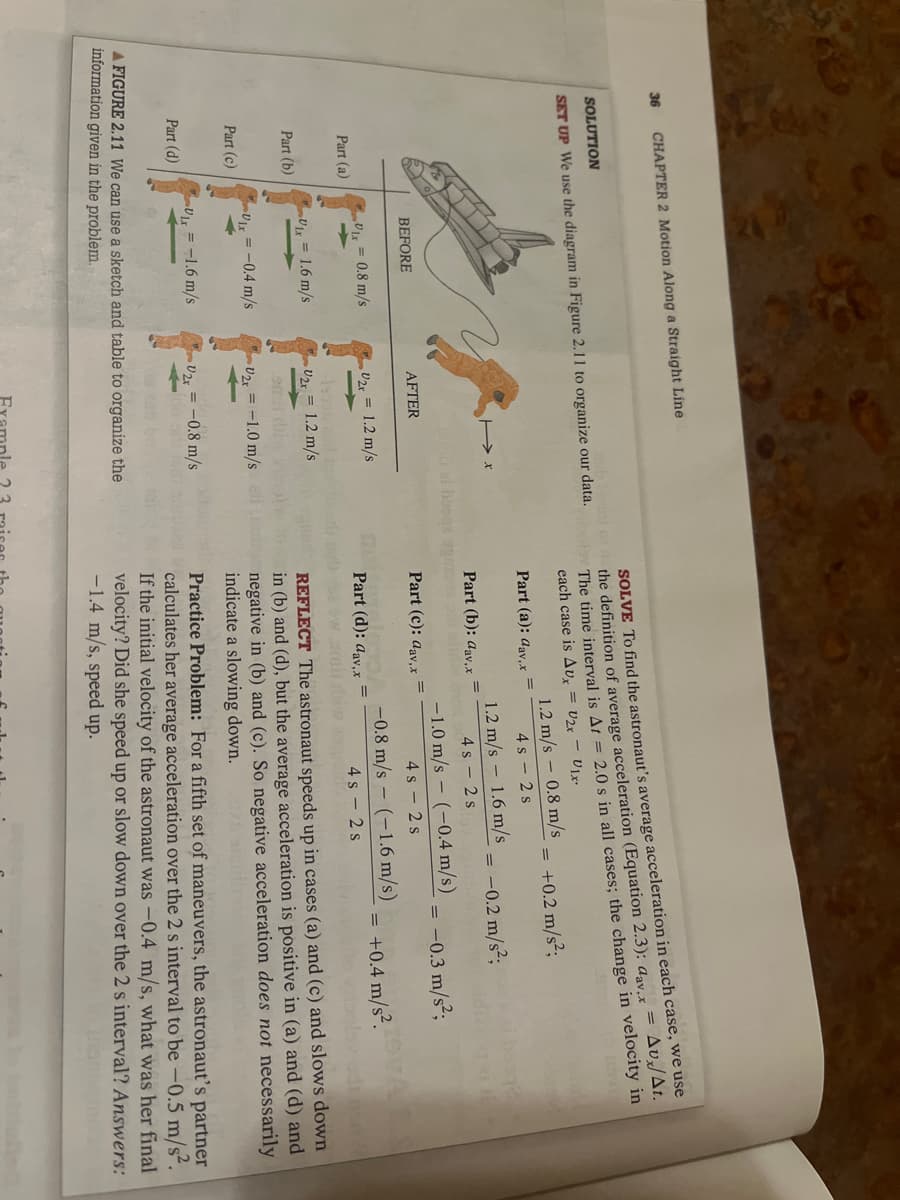marcute 10mg Practice Problem: For a fifth set of maneuvers, the astronaut's partner calculates her average acceleration over the 2 s interval to be -0.5 m/s². If the initial velocity of the astronaut was -0.4 m/s, what was her final velocity? Did she speed up or slow down over the 2 s interval? Answers: -1.4 m/s, speed up.
marcute 10mg Practice Problem: For a fifth set of maneuvers, the astronaut's partner calculates her average acceleration over the 2 s interval to be -0.5 m/s². If the initial velocity of the astronaut was -0.4 m/s, what was her final velocity? Did she speed up or slow down over the 2 s interval? Answers: -1.4 m/s, speed up.
College Physics
1st Edition
ISBN:9781938168000
Author:Paul Peter Urone, Roger Hinrichs
Publisher:Paul Peter Urone, Roger Hinrichs
Chapter2: Kinematics
Section: Chapter Questions
Problem 30CQ: Consider the velocity vs. time graph of a person in an elevator shown in Figure 2.58. Suppose the...
Related questions
Question
(Just the one practice problem worked out)

Transcribed Image Text:.
It describes how the velocity is changing with time.
The sign of the average acceleration is not necessarily the same as the sign of the
velocity. Furthermore, if the object is slowing down, then it does not necessarily
follow that the acceleration is negative. Similarly, if the object is speeding up, it does
not necessarily follow that it has positive acceleration.
EXAMPLE 2.3 Acceleration in a space walk
In this example we will use Equation 2.3 to calculate the acceleration of an astronaut on a space walk. The
astronaut has left the space shuttle on a tether to test a new personal maneuvering device. She moves along
a straight line directly away from the shuttle. Her onboard partner measures her velocity before and after
certain maneuvers, and obtains these results:
(a) U1x
V2x =
(b) Ulx
V2x =
(c) Ulx
V2x =
-1.0 m/s (speeding up);
(d) Ulx
V2x = -0.8 m/s (slowing down).
If t₁ = 2 s and t₂ = 4s in each case, find the average acceleration for each set of data.
=
=
=
0.8 m/s,
1.6 m/s,
-0.4 m/s,
= -1.6m/s,
Quet
1.2 m/s (speeding up);
1.2 m/s (slowing down);

Transcribed Image Text:36
CHAPTER 2 Motion Along a Straight Line
SOLUTION
SOLVE To find the astronaut's average acceleration in each case, we use
on the definition of average acceleration (Equation 2.3): dav,x= Aux/At.
SET UP We use the diagram in Figure 2.11 to organize our data.toy The time interval is At = 2.0 s in all cases; the change in velocity in
Part (a)
Part (b)
Part (c)
Part (d)
BEFORE
VLx = 0.8 m/s
x= 1.6 m/s
x = -0.4 m/s
Ulx
= -1.6 m/s
Hx
AFTER
U2x = 1.2 m/s
U2x = 1.2 m/s
U2 -1.0 m/s
U2x
-0.8 m/s
Part (b): dav, x
al boogs so delity
Part (c): aav, x
A FIGURE 2.11 We can use a sketch and table to organize the
information given in the problem.
each case is Aux = U2x - U1x.
no
Part (a): aav,x
1.2 m/s 0.8 m/s
4s2s
1.2 m/s 1.6 m/s
4s - 2 s
+0.2 m/s²;
Part (d): dav, x =
how brail diw
-0.2 m/s²;
-1.0 m/s - (-0.4 m/s)
4s - 2s
-0.8 m/s - (-1.6 m/s)
4s2s
=
-0.3 m/s²;
= +0.4 m/s².
REFLECT The astronaut speeds up in cases (a) and (c) and slows down
in (b) and (d), but the average acceleration is positive in (a) and (d) and
negative in (b) and (c). So negative acceleration does not necessarily
indicate a slowing down.
Practice Problem: For a fifth set of maneuvers, the astronaut's partner
calculates her average acceleration over the 2 s interval to be -0.5 m/s².
If the initial velocity of the astronaut was -0.4 m/s, what was her final
velocity? Did she speed up or slow down over the 2 s interval? Answers:
-1.4 m/s, speed up.
Expert Solution
This question has been solved!
Explore an expertly crafted, step-by-step solution for a thorough understanding of key concepts.
Step by step
Solved in 2 steps

Knowledge Booster
Learn more about
Need a deep-dive on the concept behind this application? Look no further. Learn more about this topic, physics and related others by exploring similar questions and additional content below.Recommended textbooks for you

College Physics
Physics
ISBN:
9781938168000
Author:
Paul Peter Urone, Roger Hinrichs
Publisher:
OpenStax College

Physics for Scientists and Engineers with Modern …
Physics
ISBN:
9781337553292
Author:
Raymond A. Serway, John W. Jewett
Publisher:
Cengage Learning

Physics for Scientists and Engineers
Physics
ISBN:
9781337553278
Author:
Raymond A. Serway, John W. Jewett
Publisher:
Cengage Learning

College Physics
Physics
ISBN:
9781938168000
Author:
Paul Peter Urone, Roger Hinrichs
Publisher:
OpenStax College

Physics for Scientists and Engineers with Modern …
Physics
ISBN:
9781337553292
Author:
Raymond A. Serway, John W. Jewett
Publisher:
Cengage Learning

Physics for Scientists and Engineers
Physics
ISBN:
9781337553278
Author:
Raymond A. Serway, John W. Jewett
Publisher:
Cengage Learning

Principles of Physics: A Calculus-Based Text
Physics
ISBN:
9781133104261
Author:
Raymond A. Serway, John W. Jewett
Publisher:
Cengage Learning

College Physics
Physics
ISBN:
9781305952300
Author:
Raymond A. Serway, Chris Vuille
Publisher:
Cengage Learning

College Physics
Physics
ISBN:
9781285737027
Author:
Raymond A. Serway, Chris Vuille
Publisher:
Cengage Learning